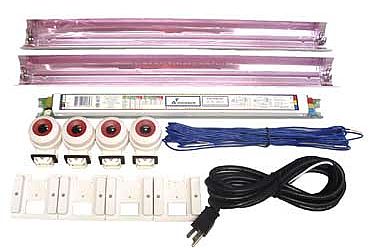The pros and cons of VHO (Very High Output) aquarium lighting is similar to those of standard fluorescent lighting systems.
Very High Output bulbs are a type of fluorescent lighting that produces a much more intense light than standard fluorescent lighting systems.
They are similar in appearance to standard fluorescent bulbs in size but require a special ballast and end caps. VHO bulbs cannot be used with standard fluorescent ballasts.
The Pros of VHO aquarium lighting are as follows:
- Light Output
VHO lamps provide a more intense light output. In general a VHO lamp is approximately three times more intense that the same size standard fluorescent bulb. This means you can use one third fewer bulbs to achieve the same desired intensity and save space in your hood or fixture. - Relatively Higher Energy Use
Although VHO bulbs require a bit more energy than standard fluorescent bulbs to operate, they are still much more efficient since only one third as many bulbs are needed to provide the same intensity of lighting over your tank. The relatively higher energy cost is offset by the amount of bulbs that need to be purchased to achieve the desired result. - Higher Kelvin Temperature
VHO bulbs produce light in the higher Kelvin range. This makes them a better choice for reef tank applications where an more intense light is required for photosynthesis. They are usually not a good choice for freshwater fish only tanks or for densely planted freshwater aquariums. - VHO Bulbs Offer A Longer Bulb Life.
Provided electronic ballasts are used, most VHO bulbs will last over a year and a half without any significant reduction of spectral quality or light intensity. This makes them more cost effective than standard fluorescent bulbs and some metal halides.
Cons Of VHO Aquarium Lighting:
- VHO bulbs produce significantly more heat than standard fluorescent bulbs.
This can raise water temperatures in your system significantly if precautions are not taken. When situated in a hood, make sure a ventilating fan is installed at both ends to bring cool air in and force hot air out of the fixture. If no fan is installed, make sure the lights are at least 12 inches above the tank to provide adequate ventilation. If water temperatures are still over limits, a water chiller may need to be added to the system.
The other Cons for VHO lighting are essentially the same as for standard fluorescent lighting, but both types are still preferred by the majority of tropical fish keeping enthusiasts.



Acropora or Staghorn corals are difficult to keep and require high water quality and water flow.
They are extremely sensitive to temperature variations, sedimentation, chemical and other environmental imbalances and because they get most of their food from symbiotic algae, they must be exposed to strong lighting.
Staghorn corals do not usually thrive in tanks using VHO lighting as the only light source and they will stress very easily if the light level and water movement is not sufficient.
We suggest starting out with Discosoma Mushroom corals. These are the easiest of all corals species to keep and they are less demanding.
Your current VHO lighting system will probably be sufficient for these corals.
JN
I have been using VHO lighting on my 55 gal saltwater fish only tank (mostly damsels)for the past year without any problems. The bulbs still seem to be putting out the same amount of light and the fish are doing fine.
I was thinking of putting a small staghorn coral in the tank. What do you think?
K.